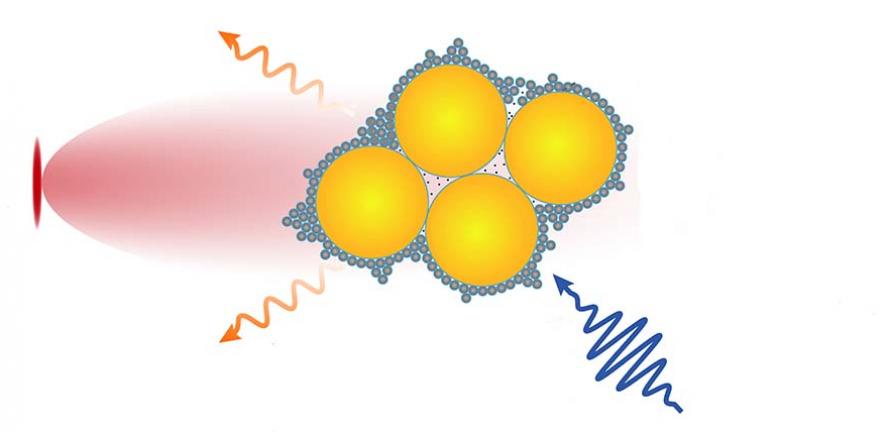2021-09-07 アメリカ合衆国・デラウェア大学 (UD)

・ UD が、鉄ベースの金属有機構造体(MOF)を室温下で電気合成する、スケーラブルでサステナブルな新技術を開発。
・ 金属原子、有機分子と微細な孔から構成される MOF は、触媒、センサーやガス貯蔵・分離のアプリケーションが期待されている材料の一つとして過去 20 年間にわたり研究されている。
・ 例えば、豆粒サイズに積層した MOF の内部表面積はサッカー場 2 個分の大きさとなり、メタンや水素等のガスの貯蔵・分離や触媒反応に利用できるが、MOFの製造には高熱、高圧力や危険な化学物質を使用する化学プロセスを要する。
・ 新技術では、熱を利用した最高の技術による MOF と同等の品質の MOF を、再生可能電力源利用による室温下にて 96%の高効率で安定・迅速・安価に形成。様々なアプリケーションに向けた実用的なMOF の開発を大きく進展させるもの。
・ MOF の実用化を阻む課題は、製造方法のスケールアップの難しさと環境負荷。電気を利用したMOF 合成の誘発では、合成プロセスに必要なエネルギー量を室温下で容易に調整できる。シンプルな電気合成技術では、商業規模の熱化学プロセスのような大型の化学プラントや高価なインフラが不要となり、研究室から商業市場への技術移転が促進される。
・ 本研究では鉄原子クラスタを利用した MOF を合成。鉄ベースの MOF 合成の試みは他にもあり、通常は鉄(3+)塩、有機分子と特定の条件下で分解する高価な溶剤を密封容器に入れ、高圧下で最低でも一日(時に数日間)加熱して作製する。
・ 新技術では、溶剤、有機分子と鉄(2+)の溶液に炭素または導電性ガラスの電極で通電すると、溶液中の金属粒子の電荷が鉄(2+)から鉄(3+)に切り替わり、高電荷の鉄原子が数分で効率良く MOF を直接合成する。溶液中に保持される MOF 材料の経時的な劣化や副反応による変化も起こらず、材料は安定性を維持したまま容器の底に残る。
・ 新技術では、MOF での優れた特性が予測されているが、従来の熱による反応には不適当であったコバルト等の材料研究の機会も提供する。
・ 導電材料でデラウェア州の形状をエッチングしたガラスの表面に MOF 材料を精確にパターニングして同技術を実証。適切な電極の利用により導電性基板に直接 MOF を成長させることもできるため、センサーとしての利用も可能となる。
URL: https://www.udel.edu/udaily/2021/september/metal-organic-frameworks-catalysis-gas-storage-sensors/
<NEDO海外技術情報より>
(関連情報)
ACS Central Science 掲載論文(フルテキスト)
Facile and Rapid Room-Temperature Electrosynthesis and Controlled Surface Growth of Fe-MIL101 and Fe-MIL-101-NH2
URL: https://pubs.acs.org/doi/10.1021/acscentsci.1c00686
Abstract
The electrochemical synthesis of metal–organic frameworks (MOFs) has been widely explored but has involved indirect routes, including anodic dissolution of solid metal electrodes or the use of interfacial redox chemistry to generate base equivalents and drive MOF assembly. These methods are limited in scope, as the former relies on the use of an anode consisting of the metal ion to be incorporated into the MOF, and the latter relies on the compatibility of the metal/ligand solution with the probase that is subsequently oxidized or reduced. We report the facile, direct electrochemical syntheses of four iron-based MOFs via controlled potential oxidation of dissolved metal cations. Oxidation of Fe(II) at +0.75 V (vs Ag/Ag+) in a solution containing 2,6-lutidine and terephthalic acid affords highly crystalline Fe-MIL-101. Controlled potential electrolysis with carboxy-functionalized ITO affords Fe-MIL-101 grown directly on the surface of modified electrodes. The methods we report herein represent the first general routes that employ interfacial electrochemistry to alter the oxidation state of metal ions dissolved in solution to directly trigger MOF formation. The reported method is functional group tolerant and will be broadly applicable to the bulk synthesis or surface growth of a range of MOFs based on metal ions with accessible oxidation states.



